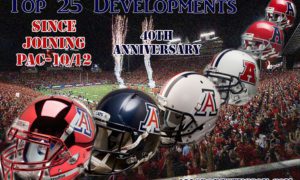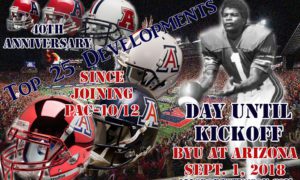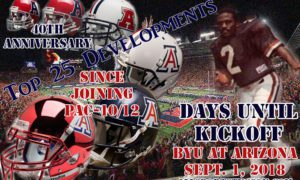Only 32 days now until when the Arizona Wildcats kick off their 2018 campaign under new coach Kevin Sumlin. The season begins when Arizona hosts BYU on Sept. 1 at Arizona Stadium.
To get ready for the upcoming season, All Sports Tucson offers another countdown, which will include memories from former Wildcats, history notes and a look ahead to the season. Think of it as a way to keep Arizona football on the mind in the summer months leading up to fall camp in early August and then kickoff against the Cougars marking the start of the Sumlin Era.
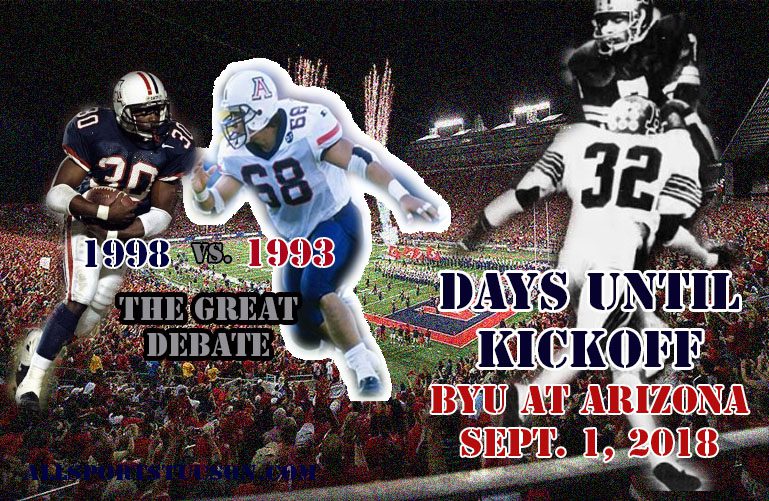
To catch up on the countdown click on this: Arizona Wildcats 2018 countdown to kickoff.
1993 vs. 1998
The season marks some substantial anniversaries. It is the 40th anniversary since the Wildcats joined the Pac-12 (went from the Pac-8 to the Pac-10 then) and also the 20th anniversary of the 1998 team with the best record in school history, 12-1, and the 25th anniversary of the 1993 team that went 10-2 with a win over Miami in the Fiesta Bowl.
A debate among Arizona followers has developed in recent years over which team was better — the 1993 team that brought the program the famed Desert Swarm defense (one of the top units in the history of college football) or the 1998 team that finished No. 4 in the nation and came basically a half away against UCLA from going unbeaten.
My colleague Anthony Gimino wrote about this debate for the Tucson Citizen in 2013.
Both teams were coached by Dick Tomey, the winningest coach in Arizona history (95-64-4 from 1987 to 2000).
We started the debate when it was 50 days to kickoff. All of the reader polls can be accessed here (you still have time to vote):
THE GREAT DEBATE: 1993 VS. 1998 READER POLLS
Mythical game Part II
The 1993 captains — Brant Boyer, Jey Phillips and Billy Johnson — locked hands as they faced midfield before walking toward the referee for the coin toss. Their teammates, including a charged Heath Bray, one of the more vocal leaders who played as tough as he talked, formed a massive group, holding hands, as they followed to midfield.
The unity brought back visions of when before the 1992 game against top-ranked Miami many of the same players stood up to the disrespecting Hurricanes and went to midfield at the Orange Bowl after the coin toss as one big solidified bunch. One of the program’s toughest badasses, Ty Parten, was not there with the 1993 team, having exhausted his ability in 1992, but his spirit was easily detectable in his former teammates as they looked across the field to the 1998 team.
Animosity does not exist between the teams — nothing like the Miami stare-down after the Hurricanes’ captains, Jessie Armstead and Kevin Williams, purposely did not shake the hands of Bray and Josh Miller after the coin toss. Soon after, the Desert Swarm was born in an 8-7 loss in which Arizona was a missed wide-right field goal by Steve McLaughlin away from winning as time expired.
No, this was like two respecting prize fighters trying to get the psychological edge by trying to look deep into their opponent’s soul.
The 1998 captains — Barrett Baker, Chris McAlister and Kelvin Eafon — stood proud with a determined look as their teammates jumped up and down behind them.
The referee asked Boyer to call heads or tails on the toss. Boyer called heads. The coin landed on the painted “A” at midfield showing heads. What does a team with a fantastic defense do in that situation? They defer, of course, putting their defense on the field first and that’s what Boyer did, despite knowing the guy in front of him — McAlister — could break a kickoff return for a touchdown any time he touched the ball.
McLaughlin put the ball on the tee, took a few steps back and waited for the signal from the referee to kick the ball.
The capacity crowd was on its feet, many of them shaking their keys, adding to the deafening sound.
McAlister, who averaged more than 26 yards per kickoff return and broke two for touchdowns in his career, stood at the goal line awaiting the kickoff. Fellow returner Jeremy McDaniel was nearby, a couple of feet in front of where McAlister was on the line anticipating being a blocker for hopefully a long return.
McLaughlin approached the ball. The crowd grew louder with each step. He booted the ball. McAlister looked skyward deep into the rich blue Tucson sky.
“This is really about to happen. Can you belieeeeve it? Folks, dreams can come true,” Keith Jackson said. “Hold the phone, the big uglies on both sides are about to be beautiful.”
Tomorrow: Full steam ahead.
A look back at No. 32
— The best to wear No. 32 is defensive back Marcellus Greene, a transfer from Cincinnati during the Tony Mason era in 1979 (also played for Larry Smith in 1980). He was a second-team All-Pac-10 selection both seasons. He also established himself as a dangerous punt returner. Greene went on to play six years in the CFL. He played the 1984 season with the Minnesota Vikings.
Wearing No. 32 now
One of the most interesting roster stories of 2018 occupies No. 32 this season. That is former Cienga standout Terrence Johnson, who has two years of eligibility remaining after playing college basketball in junior college and then James Madison through 2016-17. Johnson is a walk-on — encouraged by former coach Rich Rodriguez to join the team — but after a productive spring, he could be challenging for a scholarship soon.
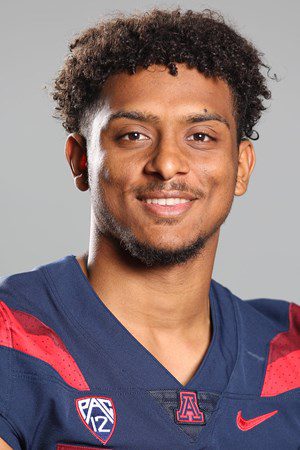
FOLLOW @JAVIERJMORALES ON TWITTER!
ALLSPORTSTUCSON.com publisher, writer and editor Javier Morales is a former Arizona Press Club award winner. He is a former Arizona Daily Star beat reporter for the Arizona basketball team, including when the Wildcats won the 1996-97 NCAA title. He has also written articles for CollegeAD.com, Bleacher Report, Lindy’s Sports, TucsonCitizen.com, The Arizona Republic, Sporting News and Baseball America, among many other publications. He has also authored the book “The Highest Form of Living”, which is available at Amazon.












